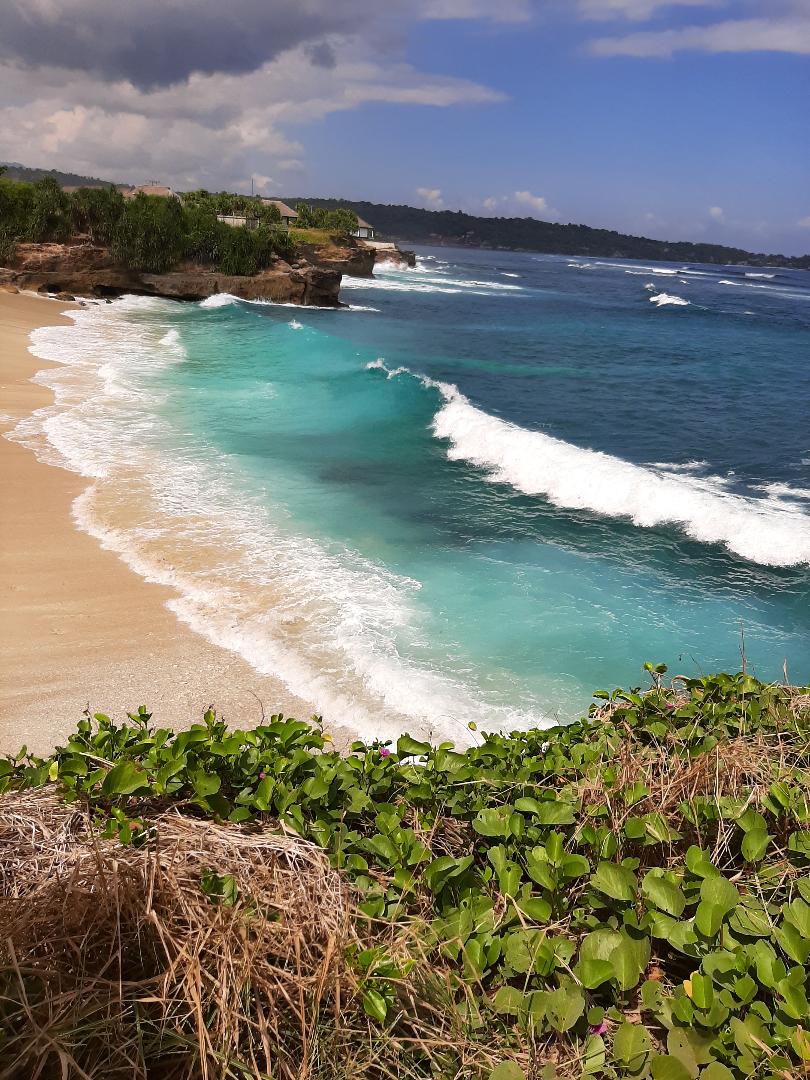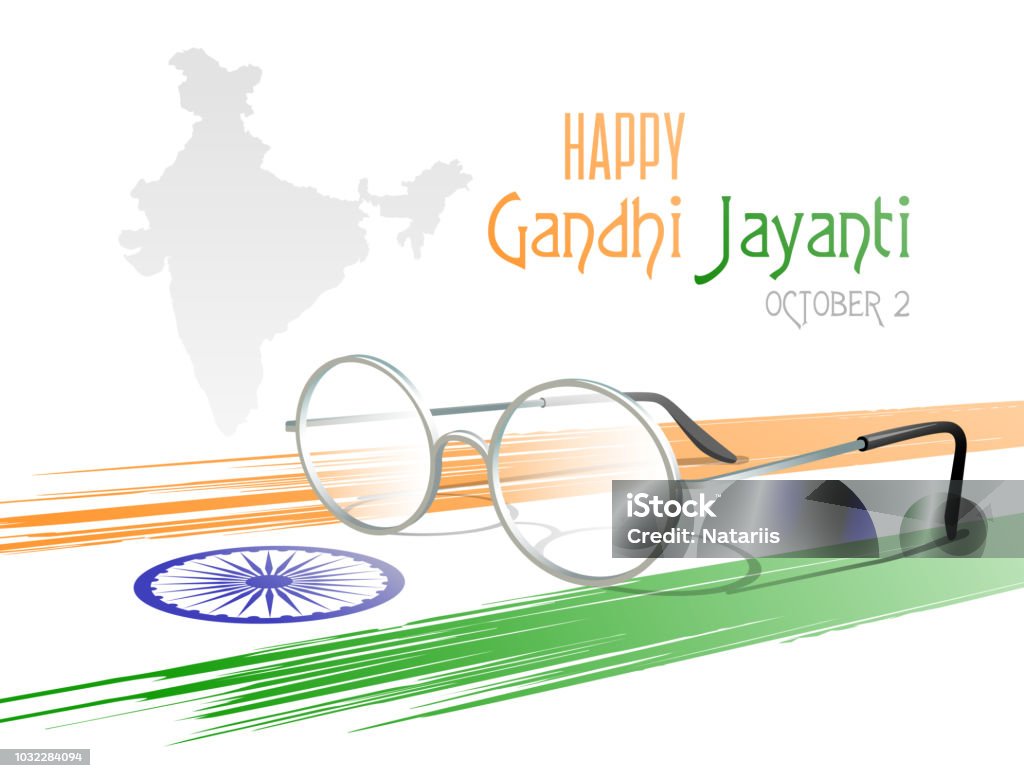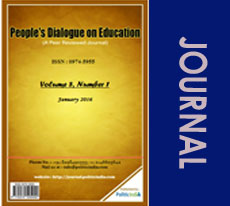TRAVELOGUE ON WEEKLONG BALI TOUR IN JUNE 2019
- Post By PoliticIndia.com on
- 16/Jun/2019

Prof. Khagendra Kumar
Chief Editor, Politic India
This summer we planned a family tour to Bali, a picturesque island of Indonesia. We started a family trip to Bali from Pune on the 6th of June, 2019. We started at around 2:00 p.m. and drove to Chhatrapati Sahu Ji Maharaj Airport Mumbai. We started our air travel at 11:50 p.m. We reached Denpasar (Bali) airport via Kuala lumpur on 7 June 2019 at around 12 noon local time (14:30 IST) after about 12 hours of travel from Mumbai. From the airport, our driver cum guide, Wayan drove us to a prior booked resort Lapiz Lazuli Villa located at Seminyak, south Bali. The resort had a beautiful ambiance with all modern facilities including a swimming pool. The villa bears Buddhist architectural frame. The cone-like sloping high roof appeared to be constructed with a meticulous wooden frame covered with flat tiles. After taking rest for about few hours we left for Finn beach. We reached the beach at around 6:30 p.m. The beach was agog with activities like eating, drinking, dancing, surfing, etc. It was flooded with over a thousand foreigners which largely included Australian, Chinese, Europeans and Japanese. We stayed there for over three hours and observed the hilarious sea waves and the people enjoying the evening. We also had a good time at the beach observing high & roaring sea waves in moonlight that finally tapered down on a well-lit sand area of the beach. Few adventurous tourists were surfing on high tides and going very far into the sea. Really they appeared to be performing a very dangerous and hilarious task. At around 10 p.m. the crowd started getting thinner and activities gradually slower. I left the beach at 10:00 p.m. for the villa.
We started the next day (8 June) at 9:30 a.m. We drove to Nusa Dua beach. At the entrance to the beach was flanked by a restaurant which used to serve traditional Balinese cuisines. Before exploring the beach we had our breakfast here in this restaurant. This beach had several water sports facilities like scuba diving, fly board, rafting, jet ski, etc. There were several shops selling local Balinese garments & goods. The price was in the range of 15000 to 250000 IDR. There were also a few other restaurants on the beach. All these restaurants normally served Balinese food. For better and close observation of the sea, few high platforms were erected on the sea side of the beach. A good number of boats of different types like pontoon, ferry, cabin cruiser, rafter, etc. were doing the rounds in the sea water. We had a good time at the beach. Two younger members of our team Vinit & Indu did scuba diving. We experienced sea waves at the beach and took a lot of photographs. We did some shopping on the beach. We enjoyed the beach for over three hours and left it at around 2:30 pm.
From the beach, we directly drove to an Indian restaurant named Delhi and enjoyed Indian food. After taking meal our guide Wayan drove us to a coffee plantation. We visited the plantation for about 40 minutes. We saw Balinese coffee and tea plants and came to know about different types of coffee and tea being prepared there. We saw the different types of coffee seeds and came to know their process of preparation. We also observed the process of making local coffee. We tasted as many as eleven kinds of coffee and tea- Bali coffee, Bali cocoa, Ginseng coffee, Lemongrass tea, Coconut coffee, Ginger tea, Rosella tea, Bali mixed coffee & cocoa, Mangosteen tea, Ginger coffee & Turmeric tea. We also bought some coffee and tea we linked from the plantation shop.
We left the plantation at 4:10 p.m. and drove for Uluwatu temple. We reached there at around 4:50 p.m. It is a very famous temple in south Bali. It was built nearly 1000 years ago during 1032-1036 AD. A small forest can be seen in front of the temple which is inhabited by monkeys which can be seen roaming here and there on the way to temple from the entrance. Precautionary message for the temple visitors to keep themselves safe from monkeys is prominently displayed at the entrance and way to the temple. It is essential for visitors to keep their lower body part from waist to knees covered while visiting the temple. Visitors are provided with 'sharong, a lungi/mundu like cloth for wearing around their waist so as to cover legs at least up to knees.
The temple is 70m higher than sea level. We visited the temple and took several photographs. The temple is perched on a steep cliff, 70m high than sea level. It was reported to us that hardly any corrosion has taken place in the cliff in spite of facing strong sea tides for the last one thousand years. It was dusk till we reached the top of the temple. Although it was somewhat dark after sunset still we had a good sea view from the top of the temple.
For reaching the top of the temple we had to scale a large number of long stone stairs. It is believed that Brahma, Vishnu & Shiva Rudra merged into one here in this temple. Shiva Rudra is worshipped here. Visitors are not allowed to go inside the temple. Prayer is done by designated priests only. On the eve of special ceremonies, temple is opened for common Balinese people. We did not find any statute inside the temple. Although big and small statues were seen at the temple entrance, terrace, and walls. We left the temple at 7:00 p.m. at the time of closure. While returning it was dark and the whole temple campus was beautifully lit in yellow light.
From the temple, we drove to paradise beach for dinner. It was around 8:00 p.m. Hundreds of dining tables were spread over the beach facing roaring sea under the umbrella of darkness. Each table was lit by candles. We had a good candlelight there. After dinner, we returned back to the villa.
Next day (9 June) we started at 8:00 in the morning for a cruise and visit to two smaller islands Nusa Lembongan and Nusa Ceningan adjacent to Bali. We boarded a ship, Glory Express at Sanur. The ship started at 11 a.m. and reached Lembongan island nearly after 40 minutes of the voyage. The sea looked hilarious as tides were continuously doing the rounds. As soon as we reached Lembongan the prior booked guide received us and informed about the places to visit. At first, he drove us to the mangrove forest. The mangrove forest surrounds the island. We sailed in a boat through backwaters watching dense mangrove forest both sides of the backwater stream. After 20 minutes sailing, we reached the sea area and finally the seashore. We took many photographs while sailing in the backwaters & sea. From here we went to Sunday beach restaurant and took some refreshment and walked on the beach area which was not at all crowded unlike all other beaches and enjoyed the cool breeze.
After taking refreshment and spending nearly an hour here we left for another sea spot popularly called Death Trap. It is a semi-circular hillock nearly 50 m high from the sea forming cave-like shape through which strong sea tides generate and strike very hard against the hillock creating a roaring sound and cloudy scene of minute water droplets. A good number of foreigners including some Indians were watching and capturing the different moments of the death trap. We also captured different events with family members. There was hutment of nearly ten shops dealing in local fruits, snacks, and handicraft items. We had fresh coconut water in a hut and proceeded for another destination.
From here we drove to the bridge connecting Lusa Lembongan & Nusa Ceningan. Now it is a fixed iron bridge but a few years ago both islands were connected by a suspension bridge which was replaced with the current bridge after a major accident a few years ago due to breaking up the suspension bridge during a ceremony.
Finally, we reached the Awareness beach at around 2 p.m. It was a very beautiful beach. The sea water appeared sky blue. A good number of foreigners were traversing on and around the beach. There was a sprawling two storey high platform restaurant facing the beach. Some tourists were busy observing the sea, some in swimming and taking a bath, some in enjoying sunbath, some in capturing moments and some were sitting in the restaurants taking meals & drinks and some. We stayed here till 3:30 p.m. taking meals, observing the sea from different places & taking a lot of photographs. We left for the seashore where the ship was waiting to take us to our return voyage to Sanur. The ship left for Sanur at 4:30 p.m. After about 40 minutes voyage we reached Sanur. Our guide Wayan was waiting there. He straight away drove us to an Indian restaurant. We took dinner there and left for the villa. Thus, our three-day tour to south Bali ended here. The next morning we had a plan to shift to north Bali for next 4 days tour.
North Bali is a beautiful place. Almost all buildings are built in a special Balinese style having a cone-like roof structure. Every house has a rectangular structure made of black stone with beautiful carvings. Use of good quality woods in making the roof frame, stairs, doors, windows, furniture, etc. was found to be very common in Bali. In common houses, rooftops were covered with beautiful tiles supported by a strong wooden frame. Although many modern houses, public/private institutions, restaurants, shopping complexes, etc. have concrete roofs they too have conical roof structure covered with tile like designs. Most of the typical Balinese houses have a small water tank in which you find small & or big pink colored auspicious fishes swimming around. Such big/small fish ponds can be seen in each eatery also. Bali primarily having a tourist economy is full of resorts. Almost all resorts have two to three spacious rooms, a swimming pool, fish tank, open courtyard, open floor covered with beautiful soothing grass and a lot of plants, flowers, and creepers. The statute of Lord Ganesh can be seen at the entrance of houses, eateries, resorts and most of the buildings & establishments. The Balinese people participate in elaborate rituals of different kinds in community temples once in a month/once in 3 months/ once in six months and make special offerings. The common Balinese people spend a substantial proportion of their earnings on these ceremonies. They start their day by offering flowers in a mini leaf basket at the entrance or sacred spots of their homes/establishments. All houses, big or small appear very neat and clean. Roads are excellent and clean. All the vehicles plying on the roads are well maintained and appear to be new. During our one weak stay in Bali, we did not come across any old & dirty vehicle. Although Bali is a den of half & scantily clad foreigners, there is no impact of such fashion and fads on Balinese people. They feel happy in their traditional attire. They are always smiling. They are quite instant in greeting to all with a smiling face and lovely gesture. They are socialized in their traditions and overall culture in such a way that the alien culture of foreigners with whom they spend most of the time could hardly leave any impact on them or we can say that have great love and faith in their indigenous culture. Their indigenous culture appears to be an amalgamation of Hinduism & Buddhism. There is hardly any prevalence of caste or creed. Their surname only reflects whether they are first or second or third or fourth child of their parents.
On the 10th of June 2019, we left for North Bali with our new guide and driver at around 9:00 morning. On the way to our prior booked resort, we visited a famous handloom and handicraft center named Sairametra Batik. Thereafter we went to a famous restaurant, Warung Tepung having hutment consisting of several beautifully decorated huts with utmost simplicity. They make an excellent place for relaxed dining. Wooden and bamboo furniture and fixtures make them very attractive. There were several fish ponds and plantations between the hutments. The restaurant had a scintillating ambiance. The meal was also very delicious. After having delicious meals we left for the prior booked resort, Visesa located at Ubud. We reached Visesa at around 12:30 p.m. After completing necessary formalities, we were made to sit on golden throne-like chairs and a priest gave us ceremonial welcome by putting a tilak of wet rice grains and tying an auspicious thread around the right wrist. Visesa is supposed to be the highest rated and biggest resort of north Bali having 7-star status. It is owned by a former king. Visesa is huge a huge resort. It has several villas divided into five blocks named after five Pandavas. We stayed at villa 505 at Nakula block. The resort has one of the finest eateries, spa, fitness center, farmhouse, gym and wifi facilities. Each villa is built in traditional Balinese style having 2-3 spacious rooms, auspicious fish tank, a swimming pool, and a basic kitchen. Each villa has a courtyard, typical of Balinese house.
Half an hour after checking in the villa we drove to Tedenungan Waterfall. To have the full glimpse of waterfall one has to walk downstairs not less than 100 meters. We went down and had a full view of the main waterfall. We looked down to the beautiful picturesque rocks and flora spreading haphazardly all around. The people enjoying adventure took bath in the falling water and tried swimming. Vinit and Indu, two younger members of our team also took bath in the falling waterfall. We snapped many photographs here. We returned back scaling hundreds of steps. We also visited local shops dealing in traditional garments and handicrafts and made some purchases.
We left the waterfall at around 6 o' clock in the evening. While returning we stopped at a wooden furniture shop having varieties of furniture and decorative items. We saw different sorts of chairs, tables, benches made of finest Balinese woods. Big decorative pieces depicting wild animals were also available, really they appeared to be the finest instances of wooden sculpture. We stayed there for half an hour and then went to a Balinese restaurant for dinner. After having dinner, we returned back to our villa at Visesa.
We started the next day (11 June) at 9:30. Our guide Ketut drove us to a place that was 70 m from the sea level for watching volcanos. We observed a live volcano. Smoke appeared to be coming out of it. Although the view was not very clear as the clouds were also doing the rounds there. We took breakfast in a restaurant at the hilltop from where we could observe the volcano with more clarity. We shot a number of photos here.
We left the place at around 12 noon and drove to another coffee plantation. This plantation was much larger than the earlier visited coffee garden in south Bali. We saw coffee & cocoa plants bearing fruits. Here too we tasted a variety of tea and coffee and also purchased some of them from sale counter here too.
We left coffee plantation at around1:30 and drove to a famous Pura Tirthempu temple. We all borrowed Sharon from the temple counter at the entrance and wore it like lungi/mundus. We entered the temple premises waring sharons. There is a holy pond in the temple premises. It is essential to take bath in the holy pond if someone wishes to perform a ritual in the temple. Taking bath in the holy pond purifies a person. Purification is essential to perform rituals there. Vinit & Indu purified themselves and performed the rituals. The temple premises have a huge mandap and a beautiful large pond having a large number of pink fishes of different sizes. Visitors are not allowed in the main temple until getting purified. Purified persons are allowed to enter into the main temple for performing rituals in the presence of priests. Many a Balinese wearing beautiful traditional attire visit temple to make offerings in a beautiful woven basket with lid. The basket contains fruits and home-made sweets. These offerings are kept on a designated platform for some time and then collected by the worshippers who made these offerings. If someone prefers not to collect the offering, it is used by the priests of the temple.
We left the temple at around 3:30. From here we went to Swings but swings were closed as the time was over. Still, we stayed there for half an hour and had a glimpse of the valley like place used for swinging. We found that swings were tied to coconut trees & did not appear to be safer. We also saw step farming being done in the area. The steep land was converted into step like plane fields in which paddy was being cultivated. In rural Bali, paddy is cultivated throughout the year. We noticed harvested paddy stocks in some fields and green paddy crops in other. In some fields, paddy crops were ready for harvesting and we also saw that in some fields plants are just at flowering stage. We happened to see large orchards of oranges in north Bali. We find coconut trees and banana plants everywhere although Bali is not a plantation economy. Its economy is mainly based on tourism and agriculture, primarily rice cultivation. Fruits and vegetables are also grown in Bali.
From the swings, we returned to the villa at Visesa by 8 pm.
On the twelfth of June, we started at 9:20 in the morning and drove to Bali Bird Park. It is a well-maintained park with hundreds of birds properly kept in their more or less natural habitat. We visited every corner of the bird sanctuary and took photographs of almost all birds.
From bird sanctuary, we drove to the Monkey Forest. We got a chance to watch different kinds of behavior of monkeys. The monkey forest is said to be divided into 7 zones. Each zone has a population of nearly 100-120 Macaque monkeys. The total population of monkey was reported to be1059. Some safety instructions were displayed at several places making visitors informed about the monkeys’ behavior and possible precautions to be taken by the visitors during their visit to the forest. We also visited Holy Spring temple several meters deep down in the forest. All the stairs for going down to the temple was made of woods. We returned upstairs through another way and visited Pura Prajapati ( Prajapati temple) popularly known as Cremation temple. In this temple, Balinese Hindus worship to God in the personification of Brahma, the Prajapati. The Balinese Hindu of the area buries their dead ones in this cemetery. They believe that the soul of the buried persons are protected and controlled by God as the Prajapati until they are cremated in the next common cremation ceremony. A periodic common cremation ceremony takes place in which all buried dead corpses are cremated. After visiting the monkey forest we straightway went to an Indian restaurant named Ganesha. We enjoyed a lot of Indian cuisines there and moved to a marketing street. We spent nearly two hours there and bought some traditional garments. After marketing, we returned to the villa at Visesa resort.
On 13 June, the last day of the trip, we preferred to stay at Visesa and explore the resort. We got ready by 9:30 a.m and went to the Visesa restaurant for breakfast. It was a buffet and we enjoyed different kinds of vegetarian and non-vegetarian dishes. After taking breakfast we went to the farmhouse of the resort spread across the huge area, maybe not less than one square kilometer. We visited stable and cowshed of the farmhouse. We visited different beautiful hutments made of bamboos, grasses & bamboo mats, wood frames & tiles. Each hut was having a different look and unique kind of sitting arrangement but everything was purely rustic and natural. In one hut, local musical instruments were kept. We tried on some of these instruments. In another hut full chess set was kept. In some huts was fitted with high stages to sit and relax in gently blowing cool breeze. There was a restaurant fitted with the best kind of wooden furniture and decorative items. We stayed on the farmhouse till evening and enjoyed local tea, coffee, and refreshments several times. The restaurant was facing a huge open area of rice fields. There were many decorated huts around the restaurant for enjoying nature. We also took massage in a spa located at the farmland. In fact, it was a great experience at the farmland. We left the farmland in the evening and walked to Padi restaurant and had delicious Balinese meals. After taking meals we walked to our villa and retired to sleep.
There is hardly much difference in the south and north Bali. The south Bali appeared to be more urbanized. The north Bali appears to be the main center of rice and fruit cultivation. As far as tourist resorts and local restaurants are concerned both north and south Bali appear to be equally rich. Both north and south Bali are equally neat and clean. Even local rural habitats of north Bali are well planned. Local roads are somewhat narrow but found to be neat and clean. Hygienic habits of the Balinese people are appreciable. People of north Bali appeared to be equally happy and smiling. To our surprise, we did not find any beggar anywhere in Bali during our weeklong stay. In fact, it is a wonderland for tourists and fulfills the international standard of a tourist place. Finally, we left the Visesa resort at 7:30 on the 14th June and returned to Mumbai via Denpasar and Kuala Lumpur at 10:40 p.m. From Mumbai we returned Pune after three and half hours drive.






